With 20 over cricket gaining popularity in the last couple of decades, the modern form of the game is now full of batsmen who love to take risks at any given opportunity. 100 years ago, no one would have imagined that batsmen would be playing reverse sweeps, switch hits, or hitting yorkers for 6 over the wicket keepers head – but here we are!
Now more than ever, batsmen are looking for creative ways to dismantle bowling attacks, and this has resulted in a range of new shots being played more regularly. Some of these shots are incredibly difficult to perfect and to play effectively. But, are they the most difficult cricket shots to play? And if not, which cricket shot IS the most difficult? In this post I’m going to give you my thoughts! I’ll tell you which shot I think is the toughest to play, and I’ll also give you a guide on how to play it yourself! As well as that, I’ll also cover some other popular shots that almost every cricketer seems to have a hard time with.
So, which is the most difficult cricket shot to play?
In my opinion, the most difficult cricket shot to play is the ramp shot. Because the shot is primarily played against quick bowlers, to play it effectively you will need to display a lot of bravery, as well as excellent hand-eye co-ordination and timing. As you can see in the picture below, due to the position your body is in during the shot, a slight miscalculation could lead to you hitting the ball towards your neck or your head. Similarly, playing the ramp against the wrong kind of delivery or mistiming the shot could lead to you getting out bowled or caught.
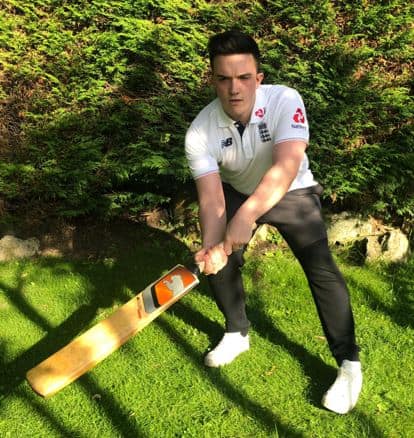
It’s also worth remembering that certain shots become a lot tougher to play depending on what type of pitch you’re playing on or what types of conditions you’re playing in. For example, it’s a lot harder to play the hook shot on a fast, bouncy pitch like the WACA than it is to play it on a slow, low pitch. It’s also a lot harder to play cover drives in England when the ball is swinging, compared to a country like Sri Lanka where the ball barely swings at all.
It’s important to mention that not every cricketer will regard the ramp shot as the hardest shot to play! Each player is different and will have different strengths and weaknesses, therefore everyone will have a different opinion on what the hardest shot to play is. Most cricketers that I speak to however, seem to say the ramp shot or one of these four shots below:
- The Reverse Sweep
- The On Drive
- The Switch Hit
- The Hook Shot
I’ll now go through each shot individually so we can see what they look like as well as how to play them. Hopefully I’ll be able to share some tips along the way that’ll help you out!
The Ramp Shot
How Is The Ramp Shot Played?
The ramp shot is a pre-meditated shot – which means that the majority of batsmen will decide to play it before the bowler has run in and delivered the ball. There are a variety of ways to play it, but I think the best one to copy is Jos Buttler – who is an absolute expert when it comes to playing this shot. The ramp is usually played to balls that land on a full length, and when a batsman plays the shot they will be targeting the areas behind square on both sides of the wicket. This is shown in the diagram below!
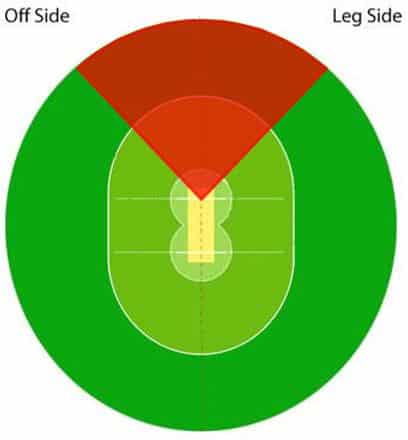
To play the ramp, follow these steps:
- Get into your normal batting stance, and prepare to receive the ball
- As the bowler is about to reach the crease and deliver the ball, walk across to the off side slightly, covering your stumps. As you make this movement, you should turn your body so that your chest is facing directly towards the bowler. This puts you in a ‘front-on’ position.
- As you turn your body into the front-on position, you should adjust your grip on the bat slightly so that the face of the bat is pointing up towards the sky. At the end of the step 3 you should be in a position similar to the one I’m demonstrating below!
- Now that you’re in position, you need to read the line and length of the delivery quickly and use your bat to deflect the ball behind square on either the off side or the leg side. Most players – including me – prefer to hit the ball towards the fine leg area! So, if you’re a right handed batsman, you should be trying to use the bat to deflect the ball over your left shoulder. Left handed batsmen will be trying to deflect the ball over their right shoulder.
- As the ball hits your bat, you should lean away slightly from the direction you’re trying to hit the ball. This is to ensure that you don’t hit the ball towards your own body.

A key thing to remember when playing the ramp is that you don’t need to try to hit the ball hard in order for it to travel a long distance! All you have to do is get your bat in the right position and allow the pace of the bowler to do most of the work for you. The most I will do is flex my wrists slightly as the ball makes contact, to give the shot an extra bit of pace if required.
If you’re ever playing this shot and using a hard ball, make sure you have all the correct protective equipment on such as a helmet and gloves. With this shot, there is always a chance you could get it wrong and the ball could fly towards your head – so it’s better to be safe than sorry! I’d recommend practicing the shot against a soft ball like a tennis ball at first to get a good feel for the movements you’re required to make!
Why Is The Ramp Shot So Difficult To Play?
As I’ve already mentioned, the main reason that the ramp shot is so difficult to play is because it’s played against quick bowlers and requires you to get into an unconventional position. The position you get your body in puts you at a slight risk of getting hit if you play your shot wrong, and it can also mean that you are less well prepared to play short balls!
When Should You Play The Ramp Shot?
There are three main things you should be looking for when you’re trying to decide whether to play the ramp shot. These are:
- The fielding team doesn’t have their third man/fine leg fielders on the boundary.
- A fast bowler is bowling
- The fast bowler is bowling a lot of full deliveries
If you spot that the fielding team doesn’t have anyone on the boundary in either the third man or fine leg positions, then this is the perfect moment to try to attempt the ramp. Ideally, once you play the shot the ball will travel in the air, over the head of any fielders that have been positioned close to the wicket – and will usually end up going for 4 or 6 runs!
As I’ve already explained, the ramp shot is much easier to play against fast bowlers because we can use the pace that they put on the ball to deflect it behind the wicket. It’s also perfect for playing against full deliveries because they allow us to get low to the ground and get the bat parallel with the floor. It’s much harder to try and ramp a bouncer because you have to reach up for the ball instead of letting it come to you.
The Reverse Sweep
How Is The Reverse Sweep Played?
The reverse sweep is a shot that is mainly played against spin bowlers, and it is closely related to the conventional sweep shot. A lot of batsmen like to pre-meditate the shot, but in my opinion it’s a shot that should be played when the type of delivery a batsman receives dictates it.
The reverse sweep is most often played to good to full length deliveries that are on the line of the stumps or anywhere on the off side of the batsman. When playing the shot, the batsman will most often be targeting the region behind square on the off side, as shown in the picture below.
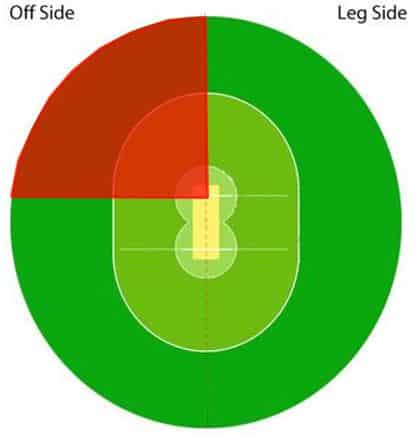
If you want to learn how to play the reverse sweep, follow these steps:
- Get into your normal batting stance, and prepare to receive the ball.
- You should be looking for a good length to full length delivery in order to play the reverse sweep. Once the ball is travelling towards you and you notice that it is going to land on a good to full length, you can make your first movement by moving your front foot down the pitch towards where the ball is going to land. As you move your front foot forwards, be careful not to stretch too far – as this could ruin your balance! Balance is key when playing this shot.
- Once you have moved your front foot forwards, sink down nice and low into your stance. Get your head over your front knee and get your eyes as low as comfortably possible, whilst keeping them level.
- As you sink down into your stance extend your bat out in front of you, with the bat face pointing towards the off side. To do this, roll your hands over whilst holding the bat! If you’re a right handed batsman, once you’ve rolled your hands your right arm should be over the top of your left arm when you play your shot. Left handed batsmen should their left arm over the top of their right arm. This is shown in the photos below!
- As the ball comes towards you, move the bat face towards the ball in a sweeping motion and make contact. Your top hand should provide most of the power – if it is required!
- When striking the ball you will have to analyse the field to pick the gaps behind square on the off-side. To get the ball to go down to the third man area try to hit the ball later and glance it off the face of the bat. To get the ball to go squarer try to hit the ball earlier and harder.

To practice this shot, I’d recommend starting by batting against a tennis ball. A drill I used to get comfortable playing the reverse sweep was to get low down in a position where I was ready to play the shot, then have a partner throw a series of balls towards me underarm so that I could get comfortable hitting the ball like that.
Why Is The Reverse Sweep Difficult To Play?
The reverse sweep is a difficult shot to play because it requires you to display good balance, timing and judgement of the ball. It also requires excellent hand-eye co-ordination. Additionally, batsmen aren’t usually playing with their hands crossed over in the way that is required during the reverse sweep, so this represents a challenge for players who are new to playing the shot!
When Should You Play The Reverse Sweep?
In my opinion, the 3 main things that should lead to you playing the reverse sweep are as follows:
- The opposition has a spinner bowling
- You’re playing on a pitch with an average/low level of bounce
- The fielding team has left gaps on the off side, or is using a predominantly leg side field
If I were you, I wouldn’t be trying to play the reverse sweep against quicker bowlers. This is because the movements required to execute the shot are much easier to perform when you have a longer time in which to do so. The slower bowling speed offered by spinners is perfect for this!
I would also think about avoiding the reverse sweep if you’re playing on a pitch where the ball is bouncing a lot. Playing horizontal bat shots on bouncy pitches is risky, because the ball can easily bounce just a little higher than you expect – leading to you getting a top edge on the ball! The reverse sweep is much more effective on pitches that display a normal, consistent level of bounce.
The factor that influences me the most when playing the reverse sweep is the field placement. If a bowler has a predominantly leg side field and isn’t giving me any width, I see the reverse sweep as a great option to hit straight balls through the off side and manipulate the field.
The On Drive
How Is The On Drive Played?
In my opinion, the on drive is one of the most beautiful shots a batsman can play. It is played against both fast bowlers and spin bowlers, and when you see one hit perfectly you will know that the batsman you’re watching is in fine form.
The on drive is played when the batsman receives a good to full length delivery which is on a middle/leg stump line or just sliding onto the batsman’s pads. The shot is hit down the ground slightly towards the leg side. You can see this zone in the picture below.
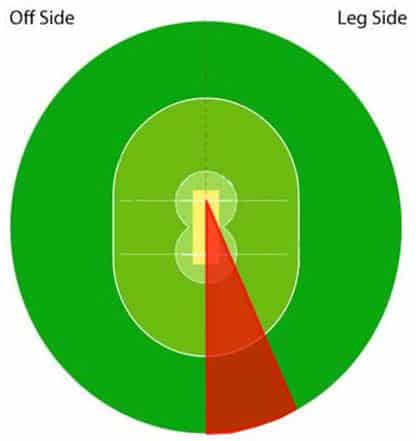
If you want to learn how to play the shot, follow these steps:
- Get into your normal batting stance and prepare to receive the ball
- Watch the ball as it travels down the pitch towards you. Once you pick up that it is going to be a full ball that is angled towards middle/leg stump, you can begin to move your front foot straight down the pitch towards the ball. This doesn’t need to be a huge movement, just a comfortable distance that doesn’t cause you to overstretch. As you move your foot, it’s important to step down the pitch with your front foot rather than across to the off side. This is because a movement across to the off side can end up blocking the path of your bat as you bring it through to play the shot. It also makes you a much bigger LBW candidate!
- Once you plant your front foot a comfortable distance down the pitch, bend your front knee slightly and move your head over that knee. Your back leg should be pretty straight at this point. Again, I’m showing this in the photo below!
- Once you’re in this balanced position, bring the bat through in a nice smooth arc and make contact with the ball. The face of the bat should be ever so slightly angled towards the leg side, so that the ball will travel in that direction once you hit it.
- Remember to display a nice high front elbow as you play the shot, as this will allow the bat to come through a lot straighter. This is the perfect technique for the on drive.

This shot is all about timing. If you make contact with the ball and bring your weight into the shot at the right moment, you won’t even need to try to hit the ball hard – it will fly off the face of the bat! If you want to learn more about timing the cricket ball perfectly, I’d recommend reading my post that covers that topic by clicking here!
Why Is The On Drive Difficult To Play?
The on drive is difficult to play because it requires a batsman to display excellent judgement, timing, and most importantly excellent balance and footwork. Batsmen who have problems with their foot movement will run into trouble playing this shot, because the feet have to be positioned nicely to allow the bat to be delivered in a smooth arc. Additionally, due to the nature of the deliveries that this shot is played to, there is a high chance you’ll be out LBW if you miss the ball! This makes the on drive a risky shot, but an incredibly rewarding one if you get it right!
When Should You Play The On Drive?
This one is pretty simple – the on drive is always a good option for batsmen, as long as the ball is in the right place. For example, if the ball is delivered on a line that is outside your off stump, there isn’t much point trying to play the on drive because the line is all wrong. A ball like this should be driven through the off side rather than the leg side. But, if you receive that juicy leg stump half volley that all batsmen dream about, then this is the perfect ball for you to play the on drive to.
The Hook Shot
How Is The Hook Shot Played?
The hook shot is a weapon that all batsmen should aim to develop. It is fantastic to use if you want to counter short pitched bowling, but it also represents a risk, as you will be playing the shot against deliveries that target your head and neck area. These kinds of deliveries are quite daunting for many batsmen, especially ones that are new to the game! This is why the hook shot is such a difficult shot to become comfortable with and play effectively.
As I mentioned, the hook shot is played to balls that are between shoulder and head height, and the delivery will usually be angled towards the batsman’s body. The shot is hit into the leg side, either aerially or on the ground. It will usually target areas between mid-wicket and fine leg. The diagram below shows the typical areas where the shot is hit.
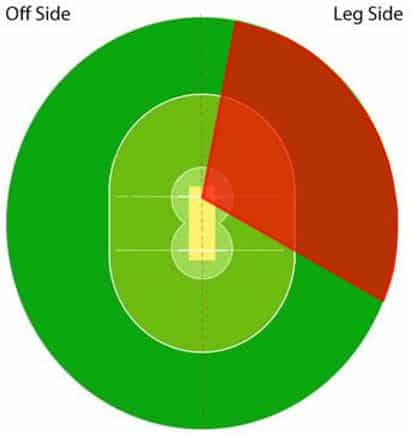
If you want to learn how to play the hook shot, follow the steps below:
- Get into your normal batting stance and prepare to receive the ball
- Watch the ball as it travels down the pitch towards you. Once you pick up that the ball is very short and directed towards your body, you should push backwards off your front foot – moving your weight backwards over your back foot.
- As your weight transitions backwards, stand up as tall as you can whilst keeping your eye on the ball. Then, begin to rotate your upper body towards the leg side. As you do this, bring the bat through in a horizontal motion to intercept the rising ball. The speed with which you rotate your upper body and the bat determines how much power you will get on your shot!
- As you make rotate your upper body to make contact with the ball, you should pivot on your back foot. Most batsmen will usually let their front foot leave the floor while this happens!
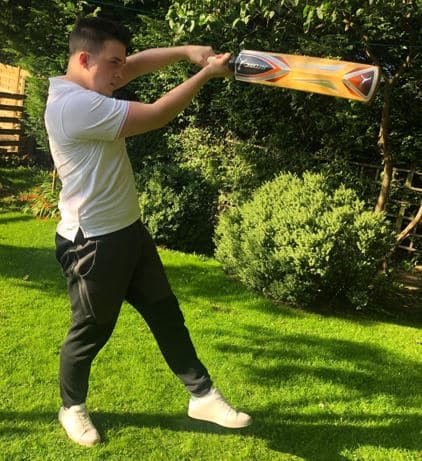
The hook shot is a shot that needs to be played carefully in order to avoid picking out a fielder. Fielding teams will usually place at least 1 (and often 2) fielders back on the boundary to cover the shot. So, you should be aiming to pick the gaps between them and to avoid hitting the ball to them at catchable heights.
Getting a faint, glancing contact on your hook shots will usually cause the ball to go a lot finer, whereas a heavier contact will cause the ball to go squarer of the wicket on the leg side. This is useful to remember when you’re trying to pick your gaps!
If you want to make sure the hook shot is hit along the floor, make sure you keep your hands high and stand as tall as you can to help you get on top of the bounce. When you’re on top of the bounce, you can force the ball downwards. Additionally, ‘rolling your wrists’ as you make contact can help you hit the ball down rather than up. To roll your wrists, simply rotate them so that the face of the bat is slightly angled towards the ground as you make contact with the ball.
If you’d like more tips on how to play the short ball, click here to read my in depth guide!
Why Is The Hook Shot Difficult To Play?
I’ve kind of already covered this above – but it’s worth writing again! The hook shot is one of the most difficult cricket shots to play because it’s usually played against the quickest bowlers and against deliveries that target vulnerable parts of our body like our neck and head. Therefore, a lot of inexperienced cricketers can be a little afraid of launching into a full-blooded hook shot in case they get it wrong and get hit by the ball! It is also hard to play whilst managing to avoid the fielders or miscuing the shot and hitting it directly up in the air!
The shot has arguably become easier to play in recent decades now that batsmen all wear helmets that protect the head and the face. Just imagine being a cricketer in the 1960’s or earlier and facing some of the world’s fasted bowlers without a helmet! In that era, the hook shot was a shot full of risk.
When Should You Play The Hook Shot?
Firstly, you should always be thinking about playing the hook shot when you receive a very short delivery that is angled towards your body or slightly down the leg side. However, I also like to use the hook shot as a statement of intent to try and disrupt the momentum of a bowler. For example, if a fast bowler is in good rhythm and is bowling a series of fast, hostile short deliveries at me, I see the hook shot as a great option to disturb this rhythm. Connecting with a couple of hooks and smashing the ball to the boundary during a passage of play like this can force the bowler to abandon their tactic and begin pitching the ball up – where most batsmen are a bit more comfortable!
Also, I always see the hook shot as a good option if the fielding team has left big gaps on the leg side boundary. For example, if they have a fine leg and a deep mid-wicket in place, this leaves a huge gap between them – a gap that is perfect for targeting with the hook! In this scenario I would try to hit the ball aerially to clear any close-in fielders, whilst making sure I pick the gap.
Conclusion
So, there you have it – my opinion on the toughest cricket shot to play, as well as a few other honourable mentions! I hope you enjoyed this post and found it informative. If you did, and you’d like to know more about batting then feel free to check out my batting tips page. There should be a post to suit your tastes there!
